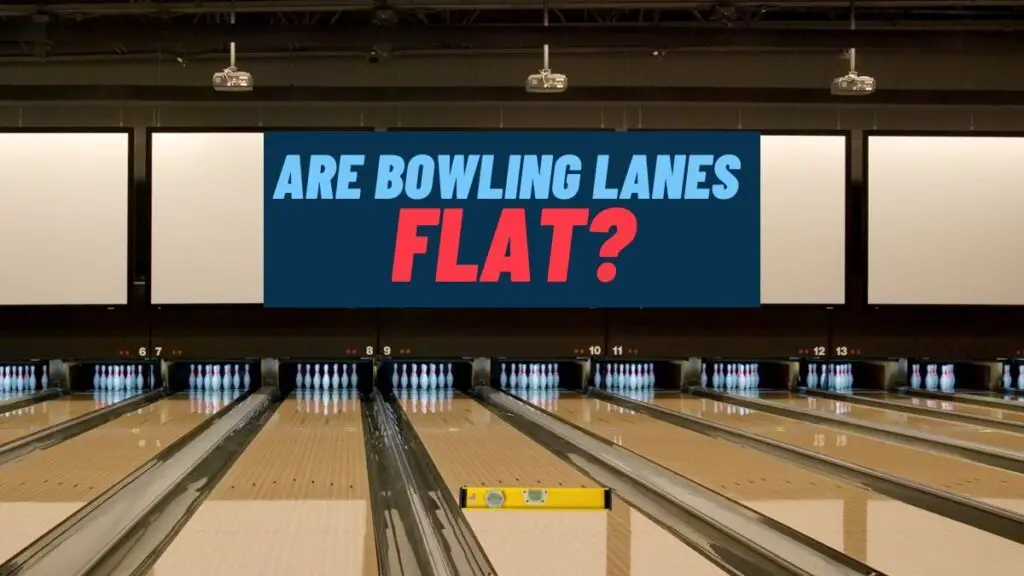Have you ever noticed how your ball moves on a bowling lane can be somewhat unpredictable and perform better on some lanes than others? Wondering if this is because the bowling lane isn’t flat? Then read on.
Bowling lanes are not flat. In fact, almost every single bowling lane is different. It is practically impossible for bowling lane owners to get the wood of the floor flat. As a result, some may have uphill slopes, others downhill. Some may even have curves.
Let’s go into a bit of depth on this. This is because we know that bowling lanes can seem flat, so it may be somewhat confusing being told they are not.

Are Bowling Lanes Flat?
Bowling lanes are designed to be as flat as possible. The problem is that it is almost impossible to get them completely flat. You can thank the wood for that. Wood contracts and expands when the temperature changes. Wood changes over time. Other factors may influence how flat that wood is lying.
This means that bowling lanes are never going to be flat. Interestingly, having a flat bowling lane is not even a requirement when it comes to tournament play. As long as the bowling alley owner attempts to get the bowling lane as flat as possible (i.e., there is no serious warping), then the bowling lane is going to be allowed.
The thing is that this does mean that each bowling lane is going to be different. Some of them are going to require you to throw the ball a little bit harder to get up a slope. Others will require you to slow down the speed because the ball is rolling down a hill. In some cases, you may even need to change the trajectory of the ball a little bit so that it is able to navigate around small bumps and other obstacles in the lane.
The reason why a bowling lane looks flat is that the bowling lane is exceedingly long. 60 feet, in most cases. The changes are only gradual, and they are invisible to the eye. However, we can assure you that those small changes will have a huge impact on how your ball moves.
Are all bowling lanes that long? Read more here: How long is a Bowling Lane?
Why Are Bowling Lanes Different?
As we mentioned before, the reason why bowling lanes are different is due to the wood. Wood is never going to lay completely flat, and it is impossible for anybody to ensure that a bowling lane is going to be flat over a full 60 feet. As a result, most lane owners will do their best to get the lane as flat as possible, and that is it.
Because wood is different, every single lane is going to be different, even at the same bowling alley. You may find that some lanes play a little bit faster while others play slightly slower. You may see that some lanes move your balls in odd ways, while others will allow your balls to fly down the lane without any real issues.
The differences between bowling alleys don’t change here either. Oh no. Bowling lanes need to be oiled. If they are not waxed, the balls will not be able to move down the lane at all. Well, they will, but they certainly will not be able to do it in the required zippy way.
Bowling companies oil their lanes in slightly different ways. How the lane is oiled will have an impact on the way that a ball moves.
Perhaps the best demonstration of this will be the difference between recreational and professional bowling alleys. If you are a recreational player, you may be able to get a few strikes here and there. This is because the bowling lanes will have been oiled in such a way that they are meant to be quite forgiving.
If you moved a decent recreational player over to a professional bowling lane, then they would struggle. They may knock down a couple of pins here and there, but it is going to be rather difficult to accomplish. This is because the oil is there purely to get the ball from one end to the other, and the oil pattern has a greater impact on the ball’s movement. Because of this, professional bowling players will need to constantly try to get a read on the way in which the lane is performing.
Read more on the topic here: How to Read Bowling Lane Oil Patterns.
What Is a Bowling Alley Floor Made Of?
To be honest, bowling alleys can be made from just about any wood. In the past, there wasn’t any real consistency when it came to the type of floor that was being used.
Nowadays, the vast majority of bowling alleys will have been made from softwood, notably pine. This is because pine is an exceedingly tough wood that manages to hold the wax well. While it is prone to warping and a bit of decay, it is a bit easier to get flatter than some of the other woods that could potentially be used for the floor of a bowling alley.
Here you can read more on the topic: What are Bowling Lanes Made of?
Many recreational bowling alleys are now starting to move towards synthetic flooring. This is because the lanes are getting a huge amount of use, and if pine is used, it will wear down fairly quickly. This synthetic flooring does behave a lot differently from wood. However, it is also a whole lot easier to keep the lane flat. Although, once again, we want to point out that the lane will never be completely flat.
Final Word
If you have noticed that your local bowling lane isn’t flat, then you are very observant. There isn’t a single bowling lane on this planet that is completely flat. It is impossible to do this. Every single bowling lane is unique, and if you want to be a top player, you need to learn how the lane you are playing on actually works.




